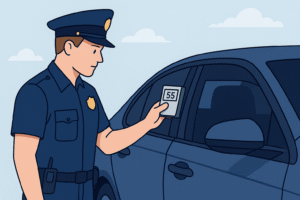What Is Legal Window Tint?
Legal window tint The darkness or reflectivity of film on vehicle windows established by state law is called the legal window tint. All states including California have their own regulations on what is allowed and what is not which typically are defined as a percentage of visible light transmission (VLT). The VLT percent will inform you about the amount of light required going through the window and the tint film combined.
The purposes behind window tinting laws in California include a trade between safety and comfort of the driver. Window tints may not only decrease glare and prevent skin damages caused by harmful UV radiation but too dark ones can limit visibility or help police not see inside the vehicle. This is the reason why there are standards and penalties against California tint laws.
California Tint Law Overview
Chapter 5 (26708) of the California Vehicle Code (CVC) is the law that governs the level of darkness or the reflectiveness of car window tint. These regulations are applicable to sedans, sport utility vehicles, and vans, and there may be minor differences with respect to the vehicle in question and window location (it could be front, back, or windshield).
The state of California has its tint regulations which are rather strict in comparison with those existing in other states. According to an initial design of the law, the aim was to enhance road safety because officers in law enforcement agencies will have a clear view of the contents of a vehicle when stopping them on the road. Failure to comply with these California tint laws may result in citations, fines, or even directed to remove the tint all together.
Legal Tint Percentage in California
In California the percentage of the allowed window tints on the front side windows should not be below 70 percent in terms of the light going through. This implies that you cannot apply a very low tint on the driver and passenger windows. There is no specified VLT restriction in case of the rear side and the back window thus darker tints can be used but only when such a vehicle has the side mirrors.
Such difference is mainly founded on visibility and safety. Both the windows of the front side should have greater visibility because they can easily interfere with the peripheral visibility of the driver and his interaction with the law enforcers when a car is pulled over. Rear windows however do not play nearly as central a role in directly offering the driver visibility nor do they have the same safety concerns (particularly when external mirrors are provided to accommodate the darker view).
The rules are even more strict on the windshield tint. The windshield can be tinted on the upper most 4 inches only with a non reflective strip. Any tint which comes lower than this is unlawful. These percentages can be imposed to secure visibility and correction of vision as to drivers, particularly, during the night or bad weather.
Is 5% Tint Legal in California?
When carrying out any desire or embarking on any wishful thing, questions like, Is 5 tint legal in California asked by many drivers are of interest. The answer is no but in the majority of situations. The tint that permits 5 percent of the amount of light, and thus is also known by that description, “limo tint,” is too dark to be legal on the front side windows or the windshield, in California.
But when used in the rear side windows, or in the rear windshield of a car with 2 side mirrors, then tint to 5 percent levels could be permitted. It should be noted that though some other shops can fit darker tint, it is the duty of the driver to ensure he or she adheres to the California tint law to prevent being cited or even having the tint removed forcefully.
Front, Rear, and Windshield Tint Rules
California has very particular and strict laws as far as which windows are allowed to be tinted as well as the allotted tint. The purpose of these rules is that they keep the drivers visible, the roads are safe and that the law enforcers can still see the traffic stop. It is vital to know how the tint laws are different, considering the various windows of your car, to ensure an offensive free regulation of the laws on the road.
Front Side Windows
The front side windows that are driver and front passenger windows must have a minimum of 70 percent visible light transmission (70% VLT) according to the law 26708 California Vehicle Code. This law makes it not difficult to make the law enforcer glimpse the windows of the front of the cars and identify the type of person occupying the car and what they are doing. Tinting more than this amount, even minimal, can lead to a ticket, or a removal notice that is mandatory. The tint should also be non-reflective with little influence on glare and at the same time low in opacity.
Rear Side Windows
In case of the rear side windows, the California law is more lenient. No particular restrictions with regards to VLT, i.e. you are absolutely allowed to use darker tints – 20%, 15%, or even 5% – on such windows. But in order to reimburse loss of visibility, the car will have to be fitted with a pair of side mirrors. The mirrors help more in providing sight to the driver particularly in backing up and changing lanes.
Rear Window (Back Windshield)
Just like the side rear window, the rear windshield can also be tinted to whatever degree of darkness as long as the vehicle is equipped with side mirrors; left and side. This versatility comes in handy to drivers that want to minimize sunlight when they have children or pets in the back seat or when they just need to have privacy on the back of the vehicle. However, safety concerns should not be forgotten as very dark tints may further block the visibility during the night or when visibility is poor due to fog; drivers are advised not to tint too darkly.
Windshield
The windshield is the window that has the most limited scope of tinting. The top 4-inches of the windshield are permitted to be tinted in the so-called non-reflective form of a sun visor. This strip reduces the sun glare which does not impair the visibility of the driver. The car must not have full windshield tints, except in case of a valid medical exemption. Illegal windshield tinting is a widely known cause of the ticket, as the person can mostly commit this cold-blooded crime at night on the road when you need visibility the most.
Medical Exceptions to Tint Laws
The Californian legal tinting regulations are high, however, there happens to be health exemptions to people who are required to use darker grades, on health grounds. Motorists who lack photosensitivity or some other medical condition making them especially sensitive to sunlight may request an exemption using the California Department of Motor Vehicles (DMV).
A licensed physician or optometrist has to produce documentation indicating that there is a medical reason that requires extra protection against UV. With the exemption, the darker tints including darker tints on front side windows which are traditionally prohibited in the standard California tint laws, would be used.
Penalties for Illegal Tint
Depending on the severity and magnitude of breaking the California window tint law, the driver can be subjected to numerous consequences. The citation may consist of a fix-it ticket, a first offense, that needs the driver to get rid of the illegal tint, and provide evidence of his/her cleanup.
Repeat cases can lead to penalties which usually begin with $25-197 per offense. In others, you might have to appear in court and your car might be impounded when the tint breaks the safety codes. Following the legal tint is a lot easier and cheaper than penalties after the fact in California. visit website for more topics.





